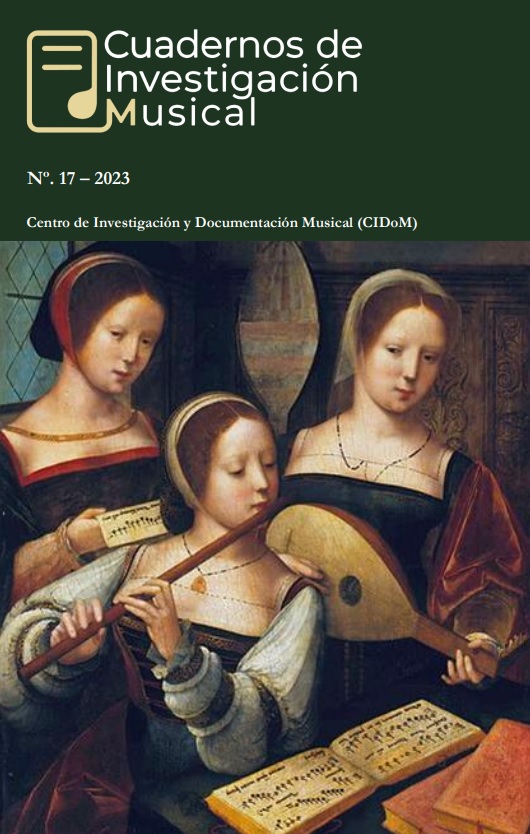The erquencho and other "southern type" idioglottal clarinets without holes
Main Article Content
Abstract
In his seminal work from 1935 on musical instruments among the indigenous peoples of South America, the Swedish musicologist Karl Gustav Izikowitz noted the existence of a group of clarinets without fingering holes and idioglottal that he called the "Southern type." Interestingly, he did not include in his list one of the few (if not the only) current survivors of that organological family: the erque or erquencho, an aerophone built and played in northwestern Argentina and southern Bolivia. Relatively simple in structure, it produces a hoarse, shrill, twangy sound over a limited range of notes, which does not prevent it from being very popular in its area of origin. Unfortunately, outside of that area it is, even today, quite unknown. The article offers a review of the main characteristics of an almost lost family, and of a sound artifact that is quite invisible and poorly executed outside of its more traditional contexts.
Article Details

This work is licensed under a Creative Commons Attribution-NonCommercial 4.0 International License.
Los autores de los artículos mantienen el copyright, no recibirán ninguna contraprestación económica por el trabajo y el mismo siempre será reconocido como exclusivamente suyo. La revista se compromete a proteger la integridad y originalidad del artículo, así como los derechos de autor que correspondan. Los autores son los únicos responsables del material, textos e imágenes que utilizan en sus respectivos trabajos, debiendo respetar siempre los derechos de autor de terceras personas, por lo que la revista no se hace responsable de lo contenido en este tema respecto al trabajo de los autores.
References
Arduz Ruiz, F. (2012). El erque. Tarija: Editorial Corpográfika.
Baldiviezo Cruz, Á. (1995). La caña y el erque, instrumentos musicales tarijeños. El País, octubre, Suplemento Cultural “Cántaro”.
Baumann, M. P. (1981). Music, dance, and song of the Chipayas (Bolivia). Latin American Music Review, 2(2), pp. 171-222.
Cavour, E. (1994). Instrumentos musicales de Bolivia. La Paz: Edición del autor.
Colbacchini, A. (ca. 1929). I Bororos Orientali "Orarimugudoge" del Matto Grosso (Brasile). Torino: Società Editrice Internazionale.
Dobrizhoffer, M. (1784). Historia de Abiponibus equestri bellicosaque Paraquariae natione. Viennae: Typis Josephi Nob. de Kurzbek caes. reg. aul. tipog. et bibliop. [Citado de la versión inglesa An account of the Abipones, vol. II, London, 1922].
Hawtrey, S. H. C. (1901). The Lengua Indians of the Paraguayan Chaco. The Journal of the Anthropological Institute of Great Britain and Ireland, 31, pp. 280-299.
Hornbostel, E. M. von & Sachs, C. (1914). Systematik der Musikinstrumente. Zeitschrift für Ethnologie, 46, pp. 553-590.
Izikowitz, K. G. (1931-2). Les instruments de musique des indiens Uro-Chipaya. Revista del Instituto de Etnología de la Universidad de Tucumán, 2, pp. 263-291.
Izikowitz, K. G. (1935). Musical and other sound instruments of the South American Indians. A comparative ethnographical study. Göteborg: Elanders Boktryckerei Aktiebolag.
Nordenskiöld, E. (1920). The changes in the material culture of two Indian tribes under the influence of new surroundings. Göteborg: Elanders Bocktryckeri Aktiebolag [Comparative Ethnographical Studies: 2].
Pérez Bugallo, R. (1996). Catálogo ilustrado de instrumentos musicales argentinos. Buenos Aires: Ediciones del Sol.
Sánchez Labrador, J. (1910). El Paraguay católico. Buenos Aires: Imprenta de Coni hermanos.
Szarán, L. (1997). Diccionario de la música en el Paraguay. Recuperado de http://www.luisszaran.org/DiccionarioPrologo [Fecha de consulta: 08/05/2022].
Vega, C. (1946). Los instrumentos musicales aborígenes y criollos de la Argentina con un ensayo sobre las clasificaciones universales: un panorama gráfico de los instrumentos americanos. Buenos Aires: AR Centurión.
